Death’s Head Hawkmoth Adult Moth
The Death’s Head Hawkmoth is the largest moth recorded in the British Isles.
In the British Isles and other cooler northern parts of its European range this magnificent insect is a scarce but annual migrant from southern Europe and Africa.
In the UK most sightings are from the southern coastal counties of England but these strong-flying moths have been recorded from as far north as Scotland’s Northern Isles.
Most migrant records occur in late Summer and Autumn when it is attracted to light.
Worldwide its resident range is extensive, extending as far south as South Africa, northwards into southern Europe and eastwards into the Middle East and Asia.
As a migrant it has been recorded as far north as southern Scandinavia and even Iceland.
The Death’s Head Hawkmoth featured was reared from a caterpillar found by Glenys Phillips and her granddaughter, Emily, in their Cornish garden as highlighted in latest sightings.
Other sightings featured are from the British Isles, other European countries, Madeira, the Middle East and South Africa.
The Death’s Head Hawkmoth feeds on sugary substances and is known for entering bee hives to feed on honey. When stressed it emits a surprisingly loud series of rapid squeaks. These presumably are a defence mechanism designed to startle and deter predators.
There has been some debate whether these noises in some way pacify bees preventing attack when the moth is inside a hive.
Moritz et al. (1991) says – ‘ that this species makes itself ‘chemically invisible’ to honeybees by mimicking the cutaneous fatty acids of its hosts.’.
Recommended reference book – Pittway’s Hawkmoths of the Western Palearctic.
Identification of the Death’s Head Hawkmoth
The Death’s Head Hawkmoth is unmistakable. With a bulky body and wingspan of up to 140mm it’s an impressive insect.
The startling skull like pattern on the thorax, behind the head, gave rise in folklore to it being known as an omen of death.
When disturbed or prior to flight, the open forewings reveal a black banded yellow abdomen and underwings.
There are two other Asian species in the genus Acherontia – Acherontia styx and Acherontia lachesis, but neither species has been recorded in the British Isles.
A. styx is very similar to A. atropos but most easily distiguished by the darker brown and consequently less obvious skull-like pattern on the thorax.
Other hawkmoths are featured in the species pages and Hawkmoth Moth Gallery.
Lifecycle
Where resident in the warmest regions of its range such as parts of Africa the Death’s Head Hawkmoth may be continuously brooded.
Further north, in cooler regions, a single brood occurs in the summer and autumn as a result of migration, yet few of the resulting pupae survive overwintering.
Eggs are laid singly on the underside of the leaves of the foodplant, several on a single well foliated plant. In warm temperatures of 20-30C or more the caterpillars grow rapidly and may be fully grown in less than 4 weeks.
Death’s Head Hawkmoth Caterpillar
The caterpillars grow to 125 mm in length, making it the largest caterpillar likely to be found in the UK.
In the final instar they are extremely variable in colour with brown, green and yellow forms. These forms are featured in sightings below.
In all instars the caterpillars are quite sedentary and remain feeding in one area of a plant until the immediate leaves have been depleted when they’ll move a short distance onto the nearest untouched growth.
The down curled, yellow or brown tail horn of a fully grown caterpillar has a rough, granulated surface.
Defoliation and the presence of large quantities of frass on the ground beneath often raises awareness of a feeding caterpillar.
When resting it may hang down, taking on the characteristic ‘sphinx pose’ adopted by many members of the Sphingidae Hawkmoth family such as the Privet Hawkmoth, Sphinx ligustri.
If disturbed the caterpillar will click its mandibles and even bite an attacker.
Other hawkmoth caterpillars are featured in the species pages and caterpillar galleries
Foodplants of the Death’s Head Hawkmoth caterpillar
Plants of the Solanaceae family, especially potato, have long been considered to be the primary foodplant of Deaths’s Head Hawkmoth larvae. Indeed, before the increased use of insecticides in intensive farming of potatoes in the UK, records suggest the larvae were found with some regularity amongst potato crops.
In recent times the small numbers still recorded feeding on potatoes are often reported from organic allotments and garden plots.
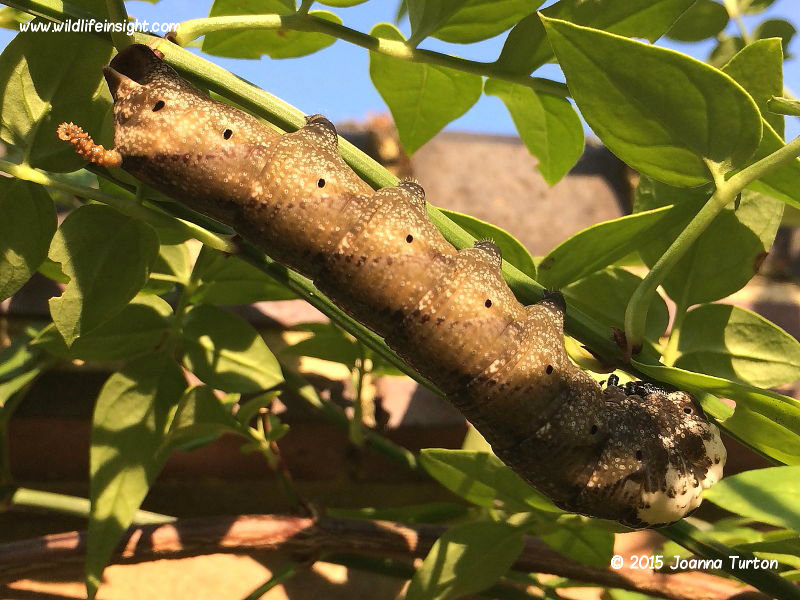
However, increasing number of sightings seem to be occurring from gardens, feeding on a variety of other plants.
With rising temperatures this may not be surprising as in other parts of its warmer, southerly range feeding is recorded on a more varied diet.
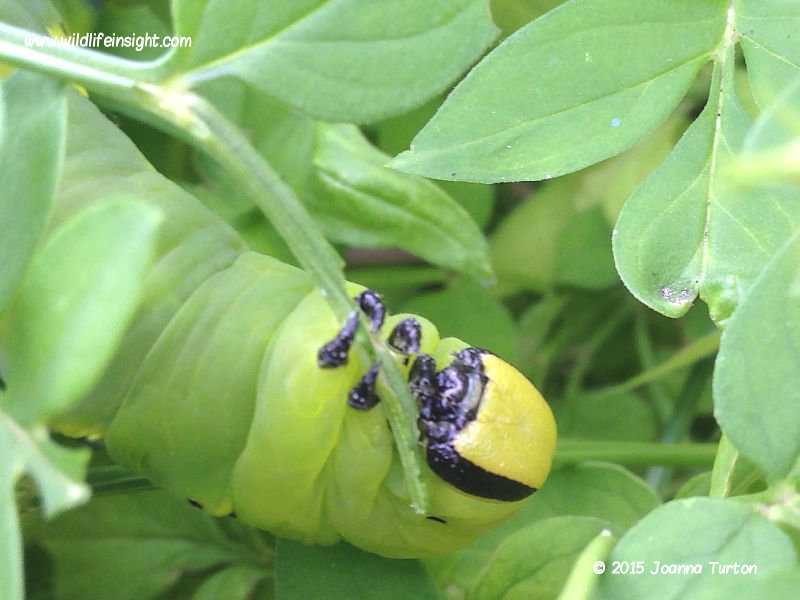
Pittaway in “The Hawksmoths of the Western Palearctic” says the larval foodplants are “principally Solanaceae, especially potato, also Verbenaceae, Oleacea (Ligustrum, Olea and Fraxinus), Beta, Nerium, Buddleja and many other plants.”
Due to the caterpillars habit of wandering away from the food plant to pupate, the foodplant is not known for all the sightings featured below.
Pupating Death’s Head Hawkmoth caterpillar
During the hours before pupation the caterpillars darken and cover their whole body in saliva.
The caterpillar then leaves the foodplant and searches for a place to pupate in the soil. It is at this time, when wandering over the ground, it’s most frequently sighted.
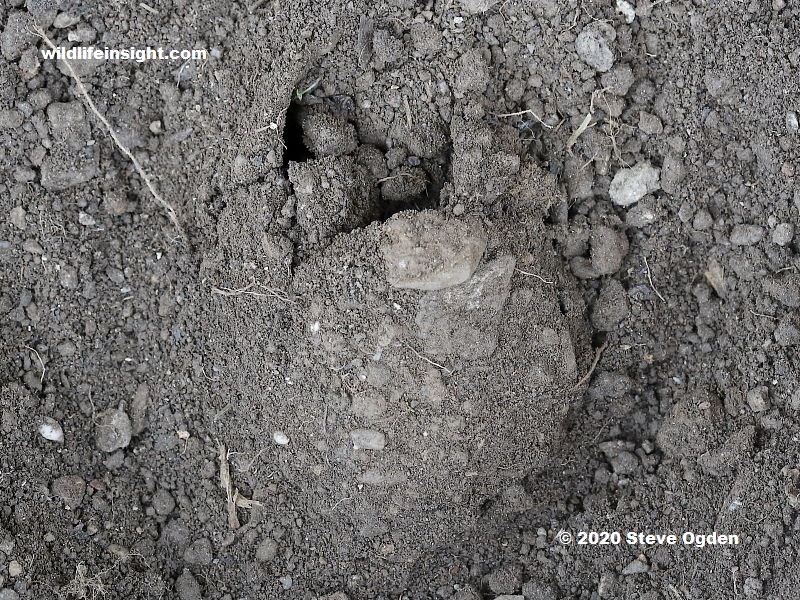
Once a suitable pupation site has been found the caterpillar digs down into the soil and forms a large, earthen shelter at a variable depth, commonly between 5 and 10 cms.
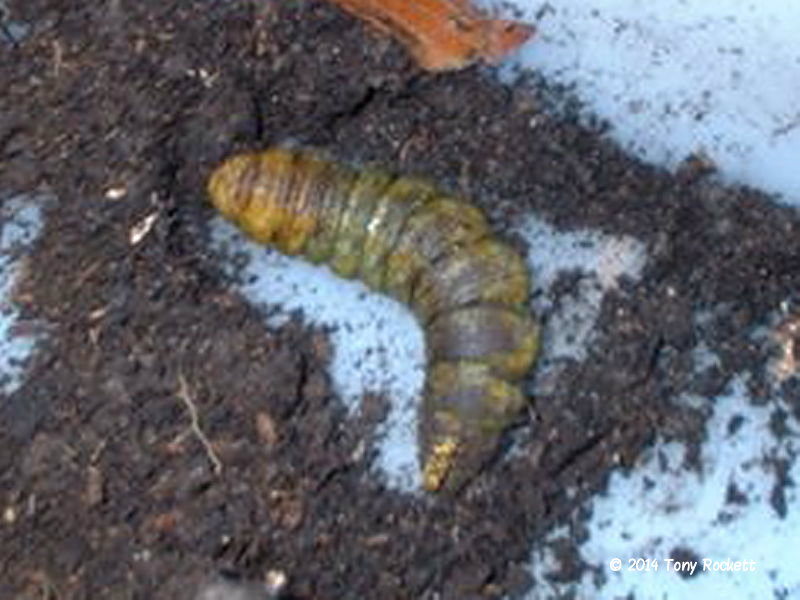
In normal summer temperatures caterpillars pupate in 4 to 6 weeks. In the British Isles most caterpillars that pupate in late autumn fail to overwinter due to the low temperatures. Those that do will emerge in the following late spring.
Recommended reference books
- “The Colour identification guide to caterpillars of the British Isles” by Jim Porter.
- “The Field guide to the Moths of Great Britain and Ireland” by Waring, Townsend and Lewington.
- “The Colour identification guide to Moths of the British Isles” by Bernard Skinner.
- Pittaway in The Hawksmoths of the Western Palearctic.
Rearing the Death’s Head Hawkmoth caterpillar
This species is one of the most popular moth species to be reared by breeders. Larvae are reared successfully on privet, jasmine and ash.
If kept between 22-25C development is rapid.
To overwinter successfully in the British Isles temperature is critical.
To encourage diapause, yet not induce premature emergence, the pupa should be kept buried in soil at a temperature of between 5-8 C in a well-ventilated cardboard box or deep tray in a rearing net. The depth of the pupa in the soil can influence its responsiveness to temperature changes.
If kept in a cool, dry room or outhouse the soil should be occasionally lightly moistened to prevent drying out but not excessively so. In late spring the pupa can be moved to a warmer site.
Death’s Head Hawkmoth sightings from around the world
The following images of sightings have been received from people all around the world. They show the variety of colour forms of the caterpillar and sometimes include the foodplant. Many thanks go to all those who have contributed.
Death’s Head Hawkmoth sightings from the British Isles

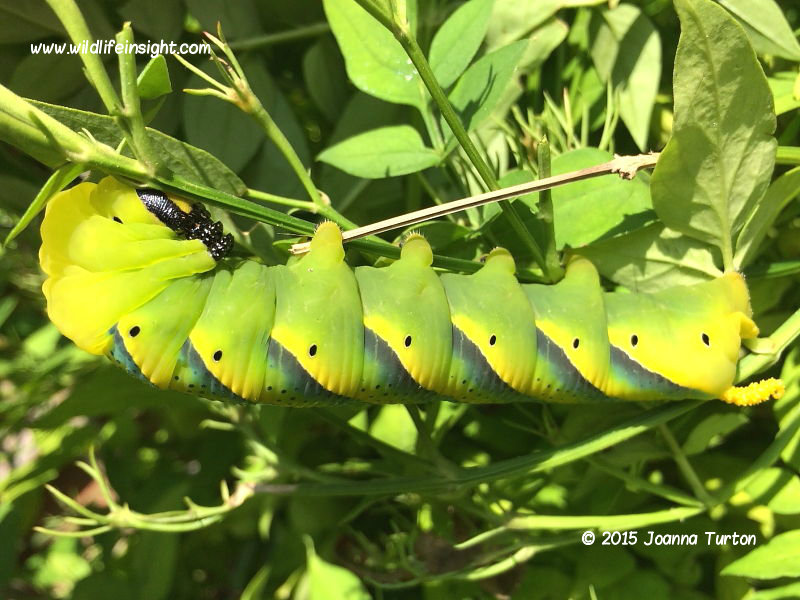
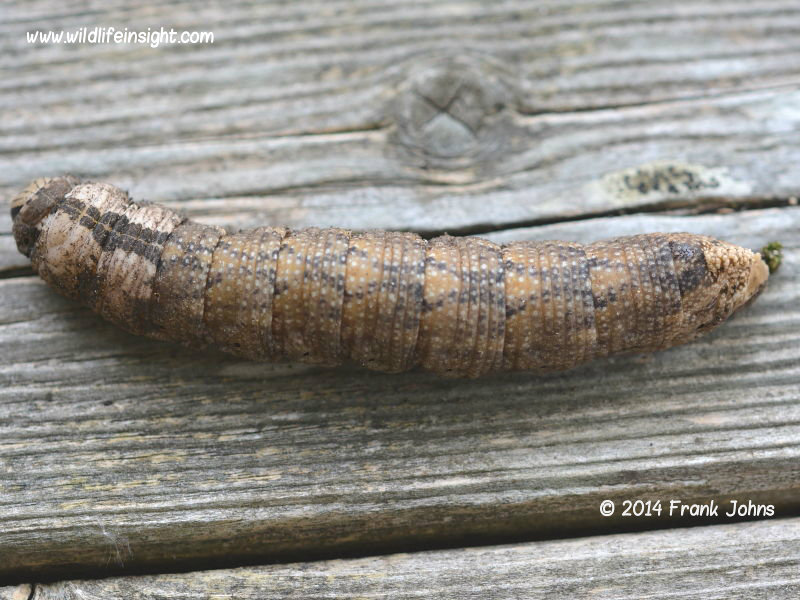
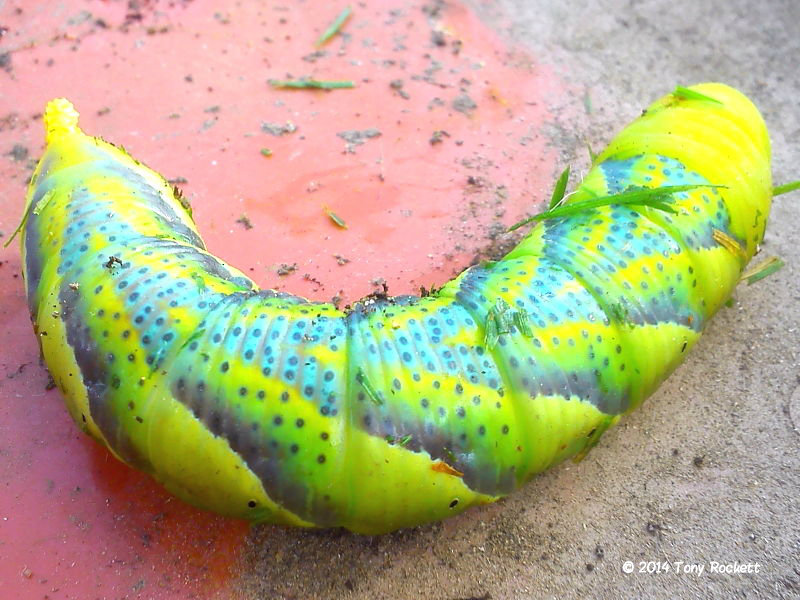
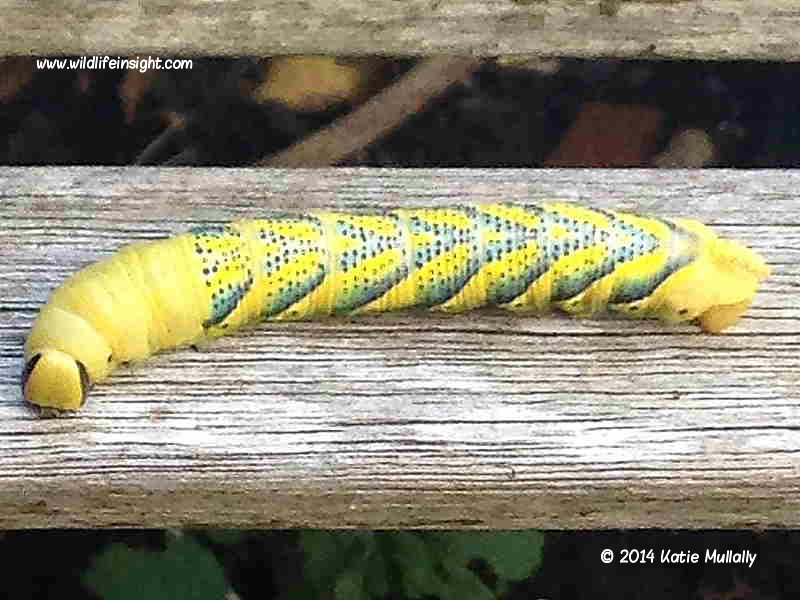
Spanish Death’s Head Hawkmoth sightings
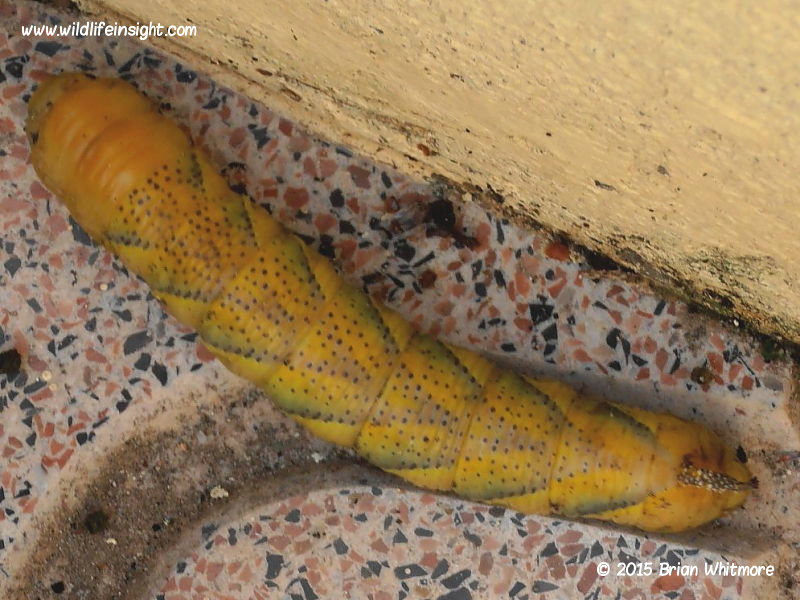
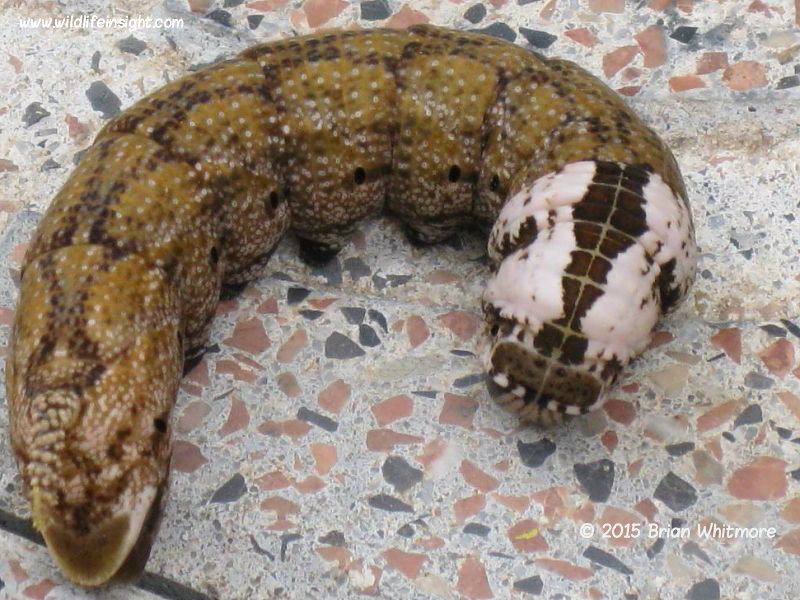
French Death’s Head Hawkmoth sightings
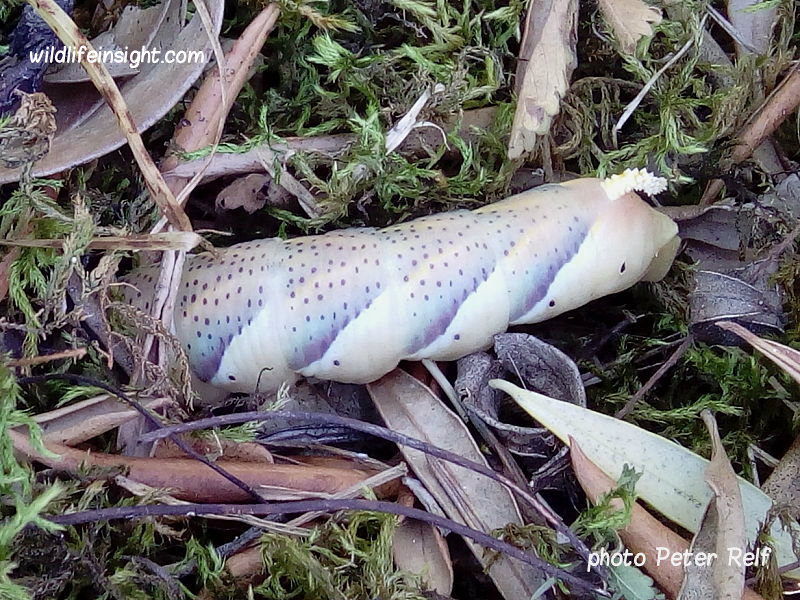
Italian Death’s Head Hawkmoth sightings
Death’s Head Hawkmoth sightings from Portugal, Cyprus, Bahrain, Slovenia and Madeira
South African sightings of Death’s Head Hawkmoths
